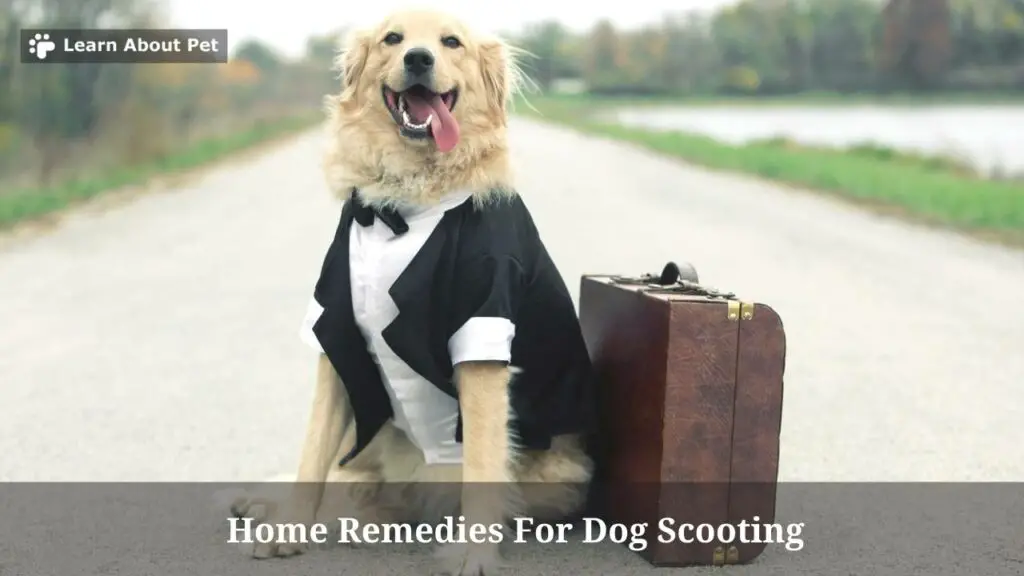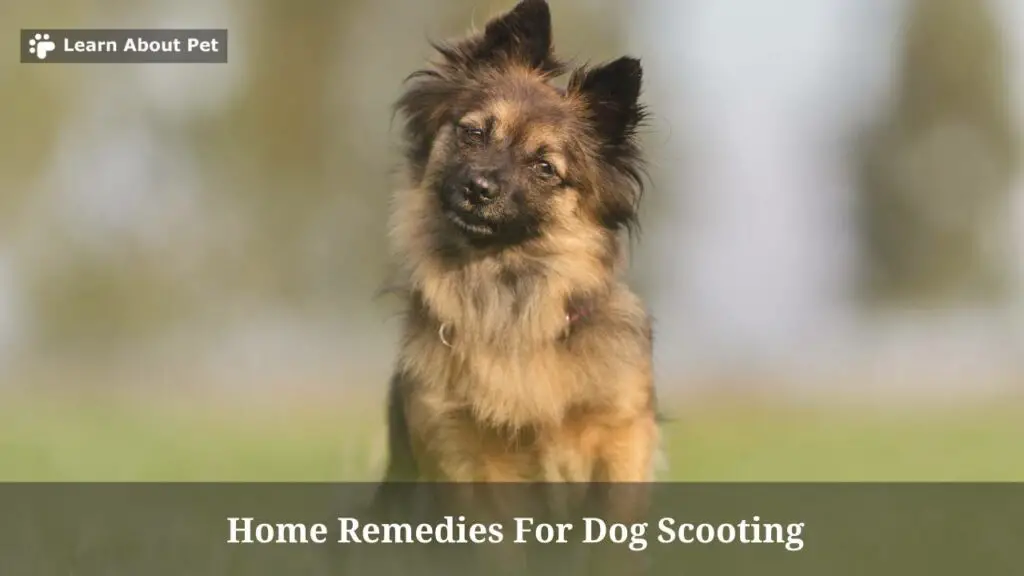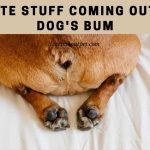Seeing the strange behavior of dogs is common for canine owners. But sometimes, some things seem concerning, like a few times the dog starts scooting their bottom across the floor and indicates something is going wrong.
Luckily, there are many home remedies for dog scooting, and you can prepare them without worrying that your dog will be in a severe situation. But why do dogs scoot their butts?
There are several dog butt scoot problems, such as inflamed dog anal glands, the dog intestinal parasites, residual dirt or poop in the dog’s bum, skin irritation, allergies, or constipation. You can do home remedies, such as applying warm compresses, expressing the anal sacs, giving antibiotics, and increasing dietary fiber.

The problem of dog scooting cannot be underestimated, and you should study it in detail. Let’s read this article to the end.
What Is Dog Scooting?
A dog scooting is a dog’s behavior that is often indicative of an anal sac issue. The dog feels uncomfortable and scratches its butt to relieve itching or pain. Sometimes the dog will lick or bite the anal area to soothe the pain.
If your dog won’t want to sit, scooting their butt to the floor, crying out when pooping, and chewing their rear end, it’s a sign your dog is having problems with his anal glands.
I can quickly think of some home remedies for dog scooting, such as warm compresses, tracking the dog’s weight, keeping the dog hydrated, and exercising, off the top of my mind.
Why Is Dog Scooting?
Dogs feel uncomfortable with itching or burning in their anal area. It’s possible for dogs scooting on the floor or carpet because their anal sacs were injured or a severe condition, such as parasites or allergies.
If your dog is whining and they are crying when you touch the dog’s anal area, immediately take your dog to the vet for a medical examination. Seeing a dog scooting once in a while is okay, but it will become a problem the more often your dog does it.
Your vet will suggest some home remedies for dog scooting, such as expressing the dog’s anal glands, applying anti-inflammatory like witch hazel, or applying fish oil to the swollen anal glands.
Why Is My Dog Scooting His Butt?
The scooting dog behavior must be searched for the primary cause. If you do not know how to distinguish the possibility of scooting, you cannot provide home remedies for dog scooting. Improper handling cannot treat dog scooting problems and can make the condition worse.
Dogs want itching, burning, or anything else that makes their butt uncomfortable to go away. Dogs cannot freely move their bodies to get rid of itchy or redness in the butt, which makes them unable to sleep well or carry out leisure activities.
Giving dogs a fibrous diet and letting them drink lots of water can prevent dog scooting problems. But we have to study something else to ascertain why dogs scoot relentlessly.
Why Is My Dog Scooting On His Bottom?
Just look at how the dog scooting on butt. If your dog is scooting just once, you don’t need to worry or take your dog to the vet. The vet will suggest taking your dog for a possible anal sac issue if it occurs several times shortly. Sometimes dogs feel an itchy feeling that continues to grow before injury or inflammation.
Check back the next day whether the dog still feels uncomfortable with the butt or not. One of the signs to watch for is a fishy smell in the dog’s butt or redness when you examine the anal area.
Why Is My Dog Scooting On Her Bottom?
Many canine owners think that dog butt scooting is a typical sign of heat, but this is wrong. There is a possibility that your dog is exposed to anal irritation by rubbing her butt on the carpet.
It’s because there are feces left in the anal area, or the dog has an upset stomach. Sometimes there is still residual stool that is difficult to come out.
My dog keeps scooting her but until I have to take her to the vet. After I took it to the vet, there were indications of worms because my dog had played in a dirty place and made the worms annoying in the dog’s butt area.
My vet suggested home remedies for dog scooting, such as compressing it with warm water while giving medicine for deworming until my dog’s condition recovered.
The remedies are done repeatedly until the scooting problem is solved.
Dog Scooting Bum On Grass
Dog scooting does not only happen as in the case of ‘why is my dog scooting her bottom on the floor‘ because dogs can be scooting wherever they want, even on grass. It’s a sign that your canine is experiencing irritation or anal gland problems.
Soap, shampoo, and warm water might help you as home remedies for dog scooting. Clean the dog’s rear end using soap and warm water with dog shampoo to get rid of toxins and fungal infections. It will help soften the dog’s dry and flakey skin.
Why Is My Dog Scooting Across The Floor?
First-time canine owners may think that scooting is normal for their pets, as they want to cool their lower bodies. But if the dog keeps scooting across the floor with other symptoms like a dog scratching its bum, or whining when you hold the rear end, something is going on.
Dogs need temporary relief from itching or pain in the rear end, even if you have hardwood floors. Some dogs can get rid of the itchy feeling by scooting on the floor but can’t get rid of the itching.
Help your dog to express the anal glands, or apply the fish oil to relieve the pain. Although the remedies are only for initial help, you can help your dog to reduce the uncomfortable feeling.
Why Does My Dog Keep Bum Scooting?
Dogs will not stop scooting on the floor or carpet if the problem is not solved. There is a possibility that your dog will get worm problems and make them feel uncomfortable after defecating. But my dog has been wormed but is still scooting afterward.
After the vet checked the dog’s condition, it was found that there was a wound in the anal area because the dog was chewing the butt area before the deworming process.
I tried doing home remedies for dog scooting by gently cleaning the dog’s bottom while doing anti-inflammatory treatments for pain relief.
Why Does My Dog Keep Scooting On The Carpet?
If your dog belongs to smaller breeds like Shih Tzus, Miniature Poodles, or Chihuahuas and looks like they’re dog scooting but on the carpet, then there’s a good chance they want to get the fluid on their anal glands but don’t know how to. The full anal glands can come out naturally for normal-sized dogs but not for small breeds.
You can help small breed dogs to express their anal glands from time to time. If small dog breeds are left full of anal glands, they can cause issues such as an anal gland abscess or infection that causes swelling in the anus area.
Don’t forget to add home remedies when your dog keep scooting, such as fish oil, Vaseline, or other anti-inflammatory to soften the dog’s rear end and reduce itching.
Do Dogs Scoot Because Of Constipation?
Sometimes dogs have trouble pooping because they don’t have enough fiber or overeat protein. If a dog is in pain because its stomach is full, then it’s a sign of dog scooting constipation.
Pay attention to the last time your dog pooped. Sometimes a simple diet change can make your dog poop like a normal period again.
If your dog continues to experience constipation problems with scooting, try taking your dog to the vet to check for foreign objects that the dog accidentally swallowed, such as grass, bones, or broken plastic.
Sometimes foreign objects will come out intact through the dog’s feces, although you have to succeed in getting your dog to poop again.
Give the dog some vegetable or fruit diet that contains fiber to launch the dog’s digestive system. Vegetables and fruits are not only home remedies but also prevention for all anal sacs problems.
Do Dogs Scoot Because Of Parasite Infection?
I see my dog is butt scooting, although there is no problem with their diet. An alarming possibility is that dogs scoot because of their itchy butt and are exposed to intestinal parasite infection.
If your dog has parasite infections, your dog will experience several symptoms, such as gastrointestinal issues and scooting across the carpet or floor. What is worrying is that you cannot immediately know the presence of intestinal parasite infection.
Many parasites can attack your dog, such as tapeworms, whipworms, hookworms, giardia, etc. You will start to notice your dog has an infection after white specks in the dog’s stool like moving around slowly. If you are observant, you will find some worms moving around the dog’s butt.
One of the home remedies for dog scooting in intestinal parasites is deworming treatment. Because many types of worms can attack your dog, it is advisable to take your dog to the vet for a medical examination.
Dog Scooting Because Of Allergies
One of the causes of dog scooting can be allergies to a specific food or seasonal changes. For example, dogs can experience wheat or soy allergies after constant consumption. The yeast infection due to allergies can cause dry, itchy, and flakey skin on the dog’s bottom.
Dogs that feel dry or itchy on the rear end will scoot their bum to the floor or carpet to relieve the itchiness. The allergic reactions can be different for every dog. You should contact your vet for possible food allergies in dogs and get dog scooting treatment.
The probiotic supplements or treats can help relieve allergy symptoms in dogs. Every dog’s diet must comply with the vet’s recommendation to avoid what your dog should not eat.
What Is The Most Common Reason For Scooting In Dogs?
Scooting dogs can be a worrying problem if your dog feels uncomfortable during the day. If you don’t give proper home remedies for dog scooting, the problem can get worse. Let’s identify some common reasons why dogs scoot.
| Common reasons dog scooting | Explanation |
| Inflammed anal glands | Dogs need their anal glands expressed. |
| Intestinal parasites | Some parasites attack dogs, such as roundworms, hookworms, tapeworms, or roundworms. |
| Dog scooting after pooping | There is residual poop or dirt on the dog’s rear end. |
| Skin irritation | There is skin irritation due to dry skin or other causes. |
| Constipation | The dog’s stomach is full, but can’t poop because it lacks fiber. |
| Allergies | Allergic effects of foods that make the skin dry and yeast infection in dog’s bum. |
The many possibilities for dog scooting on the carpet or the floor make you have to be observant of which problem your dog is facing. You can help your dog soothe the itchiness or soreness of the dog’s bum by cleaning the anal area before taking your pet to the vet.
What Can I Give To My Dog To Help With Scooting?
Dog scootching can stress your dog because of the prolonged itching. You won’t be able to see dogs trying to get rid of the itching by chewing their bum or licking them hoping the itching goes away.
Cleaning the dog’s bum is the first step before determining the problem in your dog. Try another way to give your dog a fiber diet if the problem is constipation or full anal glands.
The right food can help dogs with their bowel movement and hopefully solve the dog’s condition.
Every owner wants to take their dog to the vet for a medical examination. But there are some home remedies you can do to reduce the itchiness or discomfort when dog scooting.
10 Home Remedies For Dog Scooting
- Wipe dog’s bottom regularly with wet wipes
- Relief the dog’s inflammation with anti-inflammatory like witch hazel
- Track the dog’s weight and act fast when the dog’s lose weight
- Give regular fibrous diet
- Mix a little water into the dog’s kibble or give the dog access to a lot of drinking water
- Compress the dog’s inflamed bottom with warm cloth
- Express dog’s anal glands as recommended by the vet
- Reduce the dog’s swollen anal glands by applying fish oil
- Exercise regularly
- Give dog a probiotic supplements
You can give some home remedies according to the problem your dog is experiencing. For example, if you want to prevent full anal glands symptoms, you can choose to give a fiber diet, exercise, and express the dog’s anal glands regularly.
Food To Help Dog Scooting
The dog scooting must be cured before your dog feels the stress of having to scratch or licking its bum continuously.
Some fiber foods can help to solve some common problems with dog scooting. Pumpkin for dog scooting is a natural source of fiber and contains vitamin E, potassium, and phytonutrients.
Add about 1 teaspoon per 10 pounds of dog’s body weight, and give pumpkin without salt as a high fiber treat. Sweet potatoes are other alternatives with low in fat and rich in vitamins, calcium, and omega-fatty acids.
You can give a sweet potato in moderation to reduce the inflammation on the dog’s rear end and firm up the stool.
Sweet potatoes can be steamed and mashed to mix with the usual dog food to enhance your dog’s appetite without having to eat the potatoes alone.
The portion you have to give is the same as pumpkin, 1 teaspoon per 10 pounds of dog’s body weight.
Foods with high fiber include home remedies for dog scooting because they can overcome several problems such as treating inflammation, anal gland problems, and firming up the stool.
How Do I Get My Dog To Stop Scooting His Butt?
The best home remedies for dog butt scooting is to provide a well-balanced diet between providing fiber and protein that is right for the dog’s daily needs.
If your dog’s problem is full anal glands, then a good diet can prevent scooting due to constipation and squeeze the anal glands naturally through firm stools.
If your dog is already experiencing scooting problems, apply first aid, such as using your fingers to express the dog’s anal glands, wiping the dog’s bottom regularly, or applying warm water to compress the red area of the dog’s bum.
How Can I Soothe My Dog’s Itchy Bottom?
One treatment for dog scooting is to use an oatmeal bath. Wrap the oatmeal in a cloth and soak it in warm water, and let the dog soak it for 10 minutes or so.
Oatmeal has phenols and avenanthramides that work as an anti-inflammatory and can relieve itching. With the addition of an oatmeal bath, you get yet another home remedies for dog scooting.
How To Relieve Dog Scooting?
When the dog scooting bottom on the floor after pooping, there is a possibility of dirt or residual poop that is still attached and makes the dog itchy and want to remove the dirty part in the dog’s bum. How to relieve this problem is easy. Wipe the dog’s anal area regularly.
If the problem is constipation, you can make homemade no scoot for dogs, such as pumpkin or sweet potato mixed with the usual dog food. It will help nourish the dog with firm stool and reduce inflammation in the dog’s anal area.

Dog Anal Glands Problems
The dogs scooting on their bottoms due to full anal glands that cannot be removed. Dogs can excrete anal glands when passing their stool.
Not all dogs can be like that because some small dog breeds must be helped by their owners to express the dog anal glands once a month.
My dog is scooting on the carpet and excessively licking the anal area. My dog is a Chihuahua, and I help him to express the anal glands firmly until the fluid comes out.
How To Help Dogs Express Glands Naturally?
The dog scooting because full anal glands can be helped by providing dietary fiber. Although different from dog anus swollen home remedies, treatment by giving a good diet is the right step to prevent several problems at once, such as constipation, ruinous stool, and inflammation.
There are several home remedies for dog scooting if the dog’s anal area is swollen, such as giving calendula tincture mixed with sea salt and a cup of warm water.
Hold the cloth that has been put in the mixture to the inflamed area until the cloth is cool. Do several times for the dog swollen anus treatment until the problem is getting better.
If there is no swelling, but your dog is scooting, you can give foods that contain fiber, such as sweet potatoes, pumpkin, banana, lettuce, or carrots.
How To Express Your Dog’s Anal Glands?
If your dog has full anal glands, one of the symptoms is dogs scooting on the floor. You can help your dog deal with this problem by expressing the anal glands.
Take your dog to the vet for dog anal expression, and ask the vet how to do it at home.
If you don’t know which points can help your dog expel their anal glands, you could be causing more swelling, inflammation, and injury.
Any vet can teach you the correct way to express the dog’s anal glands without causing other problems.
Why Is My Dog Still Scooting After Glands Expressed?
When the dog keeps scooting on bottom for the next few days, then your dog gets skin irritation. Dogs will feel a little uncomfortable after their anal glands are empty, but not for more than a few hours.
Try checking the dogs scooting butt behavior, whether your dog is whining or crying when you hold the skin on the anal area. Irritation can be removed with a calendula compress to relieve the irritation and eliminate itchiness.
Food To Help Dog Express Glands
Expressing the dog’s anal glands is fine, but you will need veterinary supervision to avoid mistakes. A better way is to let dogs empty their sacs naturally. We can help our dogs by adding some high-fiber foods to their diet as home remedies.
If we already have pumpkin or sweet potato as two foods with high fiber and many benefits, we need other alternatives such as green beans and broccoli.
Green beans can be a helper for inflammation and add bulk to the dog’s poop. Vegetables can improve the dog’s digestibility, and smooth out the dog’s stool.
While broccoli can be given to dogs in small portions and contains phytonutrients and fiber.
Steam the vegetables and blend them until it has a soft texture. Start with 1 teaspoon for each pound of the dog’s body weight while seeing if your dog is tolerant of green beans or broccoli.
What Is The Cure For Scooting In A Dog?
Ignoring the cause will not cause scooting problems to go away. The dog scooting butt across the floor is not a trivial problem because we have to find out what the main cause is.
If your dog has full anal glands, the treatment is anal gland expression. You can take your dog to the vet, or you can do the procedure at home.
If there is an infection, the vet will give antibiotics and some prescriptions for pain medicine. You can give dietary fiber to dogs to reduce symptoms of itching or inflammation.
If the dog’s bottom is swelling or dry, apply Vaseline on a dog’s bottom as home remedy to relieve the pain and smooth your dog’s skin.
How Can I Treat My Dog’s Scooting At Home?
The dog scooting on carpet problems must be addressed immediately before the symptoms get worse.
There are several home remedies for dog scooting that you can do, such as cleaning the dog’s bottom every day, giving the dog a fiber diet, keeping the dog hydrated, applying Vaseline or fish oil to the swollen anal glands, or applying warm compresses to the dog’s inflamed anus.
Home Remedy For Dog Scooting
My dog is scooting her but on the floor, and we as owners can’t bear to see the dog’s condition feeling uncomfortable with their bum.
Find a home remedy for a dog’s itchy bum by learning how to express a dog’s anal glands or cleaning the dog’s rear end with wet tissue until no dirt remains.

Final Verdict – Home Remedies For Dog Scooting
Dogs scoot on the carpet or floor because they feel uncomfortable with the rear end. The causes of scooting dogs vary, ranging from full anal glands, skin irritation, residual poop, constipation, and food allergies.
Ignoring the root cause of dog scooting will not solve the problem and keep your dog itching in the anal area. You can take your dog to the vet for a medical examination, or you can do prevention by giving your dog proper dietary fiber, cleaning the dog’s bottom regularly, and expressing the dog’s anal glands firmly.
As a pet lover, make sure to learn about pet more and give your pet dog a good and comfortable life!

Welcome to Learn About Pet. My name is Rajkumar Ravichandran and I love all pets, travel, and amazing food. I write about my passion and personal experience caring for multiple pets in this blog! ❤️
Post Disclaimer
DISCLAIMER: THIS BLOG OR WEBSITE, "Learn About Pet", DOES NOT PROVIDE YOU WITH MEDICAL ADVICE AND IS NOT A SUBSTITUTE FOR MEDICAL ADVICE. ALWAYS GET IN TOUCH WITH YOUR PERSONAL VETERINARIAN AND USE INFORMATION HERE AS GENERAL ADVICE.
The information, including but not limited to, text, graphics, images and other material contained on this website are for informational purposes only. No material on this site is intended to be a substitute for professional veterinary advice, food recommendation, diagnosis, or treatment. Always seek the advice of your veterinarian or other qualified health care provider with any questions you may have regarding a medical condition or for pet food related questions.







